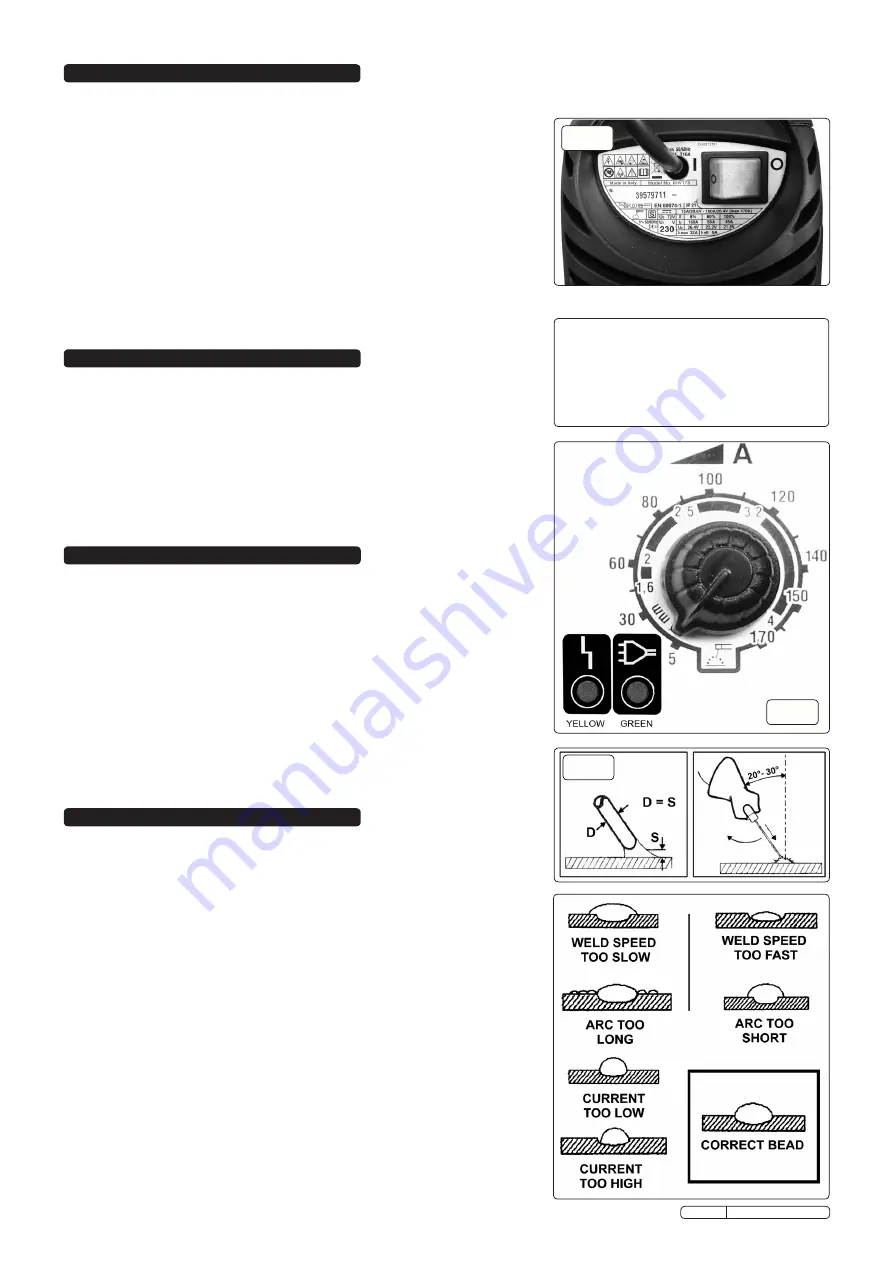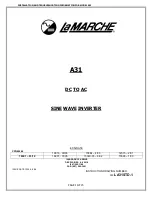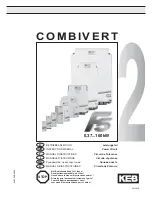
7. CONTROLS
8. PREPARATION
7.1. BACK PANEL (Fig.5).
Rocker switch. Turns mains power on and off.
7.2. FRONT PANEL (Fig.6).
7.2.1.
Potentiometer.
Regulates welding current with graduated outer scale in Amps.
May be adjusted during welding. Inner scale indicates recommended settings
for different welding rod diameters.
7.2.2.
Green LED.
Mains power indicator, machine ready.
7.2.3.
Yellow LED.
Normally off. ‘on’ indicates that there is no welding current due to
one of the following faults:
1. Thermal protection: Inside the inverter the temperature is excessive. The
machine is on but does not deliver current until a normal temperature is
reached. once this happens the re-start is automatic.
2. Mains over/under voltage protection: When the supply voltage is too high
(over 260Vac) or too low (under 190Vac) the machine is blocked.
3. Short circuit protection: If there is a short-circuit lasting more than 1.5 secs
(i.e. electrode sticking), machine stops. Re-start is automatic.
8.1.
The welding current must be regulated according to the diameter of the
electrode in use and the type of joint to be welded. See diameter/current chart
to the right.
8.2.
Further consideration must be given to the location of the weld, for example:
Welds that are performed on a horizontal surface require a higher voltage than
those performed on a vertical or overhead surface.
8.3.
The mechanical character of the weld will be determined not only by the current
used, but also by the diameter and quality of the electrode, the length of the arc
and the speed and position of the user. The condition of the electrode is an
important factor and it must never be wet or damp.
WARNING! Ensure that you read, understand and follow the safety
instructions. Place the welding mask in front of your face before striking
the arc.
9.1. ARC WELDING
9.1.1. Strike the electrode tip on the workpiece as if you were striking a match.
WARNING! DO NOT hit the electrode on the workpiece, as this may damage
the electrode.
9.1.2. As soon as the arc is struck, maintain a distance from the workpiece equal to the
diameter of the electrode. Keep this distance as constant as possible for the
duration of the weld. As you advance along the workpiece the angle of the
electrode must be maintained at between 20º and 30º. See fig.7.
9.1.3.
At the finish of the weld, bring the end of the electrode backward in order to fill
the weld crater and then quickly lift the electrode from the weld pool to extinguish
the arc.
9. WELDING PROCEDURE
10. MAINTENANCE
WARNING! BEFORE CARRYING OUT ROUTINE MAINTENANCE, SWITCH
OFF THE WELDING MACHINE AND DISCONNECT IT FROM THE MAINS
POWER SUPPLY.
WARNING! IF THE WELDING MACHINE IS NOT FUNCTIONING PROPERLY
REPAIRS SHOULD BE CARRIED OUT ONLY AND EXCLUSIVELY BY
AUTHORISED SERVICE ENGINEERS.
WARNING! BEFORE REMOVING THE WELDING MACHINE PANELS,
SWITCH OFF THE MACHINE AND DISCONNECT IT FROM THE MAINS
POWER SUPPLY .
10.1.
Periodically remove the casing and, with a low pressure air flow (max 10bar),
remove dust from inside the machine paying particular attention to transformer,
reactance and rectifier.
10.2.
do not direct compressed air onto the electronic circuit boards, these should be
cleaned with a very soft brush.
10.3.
ensure that all electrical connections are tight and check the wiring for damage
to the insulation.
10.4.
ensure that the casing is correctly replaced and secured before attempting to
use the inverter.
10.5.
Keep the outside of the machine clean by wiping with a soft, dry cloth.
For any other service or maintenance, contact your local Sealey service
agent.
Original Language Version
fig.6
Electrode
Welding Current (Amps)
Diameter (mm) ......... Min .......................Max
1.6 ............................... 25 .........................50
2.0 ............................... 40 .........................80
2.5 ............................... 60 .........................110
3.2 ............................... 80 .........................160
4.0 ............................... 120 .......................200
MW175 Issue No.1 27/10/11
fig.7
fig.5

























